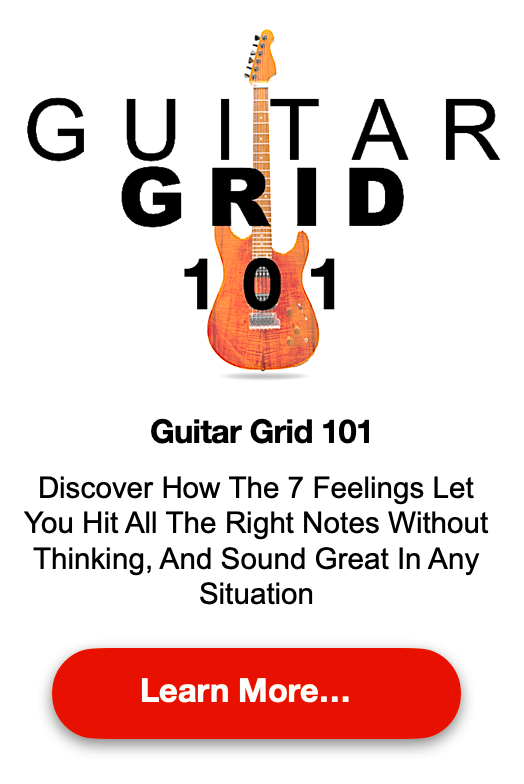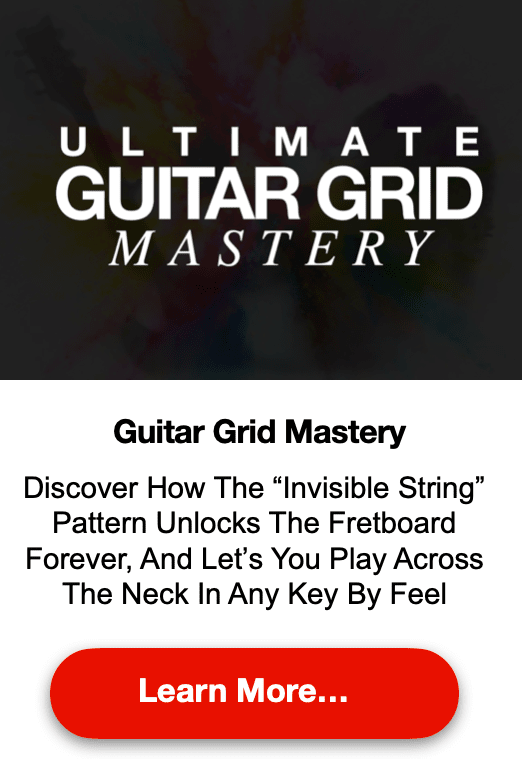Do you struggle with the maze that is the guitar fretboard?
Do you feel that learning the notes would help you, but you imagine it taking forever, don’t know where to start, or just feel overwhelmed?
Instead of wasting weeks scouring the internet or painstakingly drawing notes on paper, these 3 simple guitar exercises will put the notes in plain sight.
Spend just two minutes on each guitar exercise, each day for one week, and that nagging feeling will be gone forever! And you’ll never again feel like you’re missing out.
Locating bar chords, finding scale positions, and even creating new chords will become an enjoyable breeze.
You Won’t “Memorize” Your Way to Learning the Fretboard
Have you ever seen one of those fretboard diagrams with all the note names? Yuck!
What a mess. I’ll bet virtually NOBODY can remember the notes that way.
Looking at a chart and trying to “memorize” the notes doesn’t work. Why?
Simple…
Imagine you saw a picture of the front of a house.
If you saw the same picture later, would you recognize the house? I’m sure you would.
But what if you were shown a picture of the side of the house? Could you tell it was the same house? It’d certainly be tough.
It’s easy to remember what the front of the house looks like because in the picture, you’d seen it from that “angle” before.
Whatever You Memorize, You Recall it the Same Way
Even though you saw the house in the first picture, it’d be virtually impossible to identify the house from an angle you hadn’t seen.
It works the same on guitar.
If you memorize the notes on the guitar from “one angle”, then you’ll only be able to recall them in that same way.
For example. Imagine you’re learning the note names on the low E string by memorizing the notes in order from the 1st fret, 2nd fret, 3rd, 4th, and so on.
By the time you get to the “A” note (5th fret), you probably won’t know where “A” is – relative to the whole fretboard…
…you’ll just know that it comes after G# (on the 4th fret). This is because your focus was on “what note comes after G#?” and not on “where am I on the fretboard?”.
And that’s the problem.
If I asked you to play an A note, you’d probably recall it the same way you memorized it. By “counting” up – 1st fret, 2nd fret, 3rd, etc – until you arrived at “A”.
I see this happen all the time.
Obviously, “counting” to find the notes isn’t going to help when playing songs or solos.
You want to go straight to the note.
How to Instantly Recognize the Notes from Any Angle
Imagine the house again.
If you were able to see the house from the front, side, and back, you’d have a much more complete view of the house.
Just like your own house, you’d recognize it in any picture.
By finding the notes from different angles, you’ll recognize them from any angle too. And eventually, you’ll have the “whole picture” of your fretboard.
That’s our goal. So how do we do it?
By using the notes, not just memorizing them.
How to Use the Notes so You Can’t Forget Them
For these “mini-exercises”, we’re only going to discuss the “natural notes”.
Natural notes are the letters of the alphabet (A, B, C, etc.) with no sharps (#), or flats (b).
Reason? If you know where the natural notes are, you also know where the sharps and flats are (down one fret [flat] or up one fret [sharp] from the natural note).
Also, we’ll do each exercise on one string.
If you really want to lock the notes in your brain, stick with the same string for an entire week.
Start with the low E (fattest) string. Practice these exercises on that string for one week. Then move in order across the strings: from E to A to D to G to B to e – spending a week on each string.
Just for example, we’ll “walk through” all three exercises as if we were doing them on the low E string. Here are the natural notes on the Low E string (remember that the “open E” string is on the “zero fret”):

Exercise #1 – Up/Down
Simply play the open E string, and say the name of the note out loud (critically important)!
Then, move to the first fret, play the “F” note while saying it out loud. Then move to the “G” note. Play it and say it. Continue “playing and saying” the natural notes out loud “UP” the fretboard to the 12th fret (which is E again).
Then, repeat in reverse. The 12th fret would be “E”, the tenth would be “D”, and so on. Don’t forget to play it and say it, every single time.
When you say the name of the note out loud as you play it, it helps your brain make a connection with your hand. Eventually, your hand will have a mind of it’s own and will go straight to the note without you thinking about it.
Set a timer, and repeat this exercise for 2 minutes.
Exercise #2 – Fourths
In this exercise, you’ll play and say the notes, just like in Exercise #1, but in a different order.
Here is the order to play the notes for this exercise:
B E A D G C F
Just like with exercise #1, repeat for 2 minutes.
Also, remember that you’re only playing on the low E string.
Exercise #3 – Fifths
For the last exercise, you’ll continue to “play and say” the notes, but again in a different order.
Here is the order of the notes for Exercise #3:
F C G D A E B
Once again, practice exercise #3 repeatedly for two minutes.
The total time for all three exercises is just 6 minutes!
How to Practice These Exercises for Maximum Effectiveness
STAGE 1
To start, simply focus on completing each exercise (getting through all the notes). If you did it once, you can do it again, right?
Just focus on doing each exercise for 2 minutes with a focus on being accurate. Don’t worry about how fast you’re going. This is not at all important.
STAGE 2
Once you are able to complete each of the exercises, then it’s time to increase the challenge by playing and saying the notes with a beat.
This will help lower your “recall time” to make recognizing the notes instantaneous. And after all, music is played to a beat, right?
You can use a metronome if you want, or if you have a good sense of internal rhythm, you can keep the beat yourself.
In a group of 4 beats, play and say each note on beat number 1. For example, if we were practicing Exercise #1 on the low E string, it would sound like this:
E.. 2.. 3.. 4.. F.. 2.. 3.. 4.. G.. 2.. 3.. 4.. … making sure to say the name of the note out loud.
The key here is to play your beat slow enough that you can accurately arrive at and say the right note on each “first” beat. If you can’t do this, your beat is too fast. Slow it down and repeat.
Once you feel comfortable naming the notes at a certain speed, increase the speed! For all three exercises.
But don’t worry about being a speed demon with this. If you can accurately name the notes in all three exercises at a decent pace, all you need is repetition.
Of course, using the notes in an actual musical situation is most important. That’s the next step.
Lock in the Notes for Good by Playing Bar Chords and Power Chords in Songs
You can do each of the three exercises on each and every string. I recommend it, of course.
But for finding bar chords and scale positions, the most useful strings for most people to know the notes on will be on the E and A strings.
Start with the E string for one week. Then move to the A string for one week. Then move on to the other strings. It only takes 6 minutes!
The last step is to lock in your practice by playing real music.
Practice playing your favorite songs using only power chords, or only bar chords starting from the low E string and A string.
Try playing all the chords starting from the E string. Then the A string. Then mix it up and switch between both strings in the middle of the song.
This will force you to use the locations of the notes you learned so they will stay locked in your mind forever.
Conclusion
With just three super-easy guitar exercises anyone can do, you’ll finally eliminate that nagging voice in the back of your mind – that constant reminder that you should learn the notes on the fretboard.
The three exercises are:
- Up/down
- Fourths
- Fifths
With just 6 short minutes a day, the notes will become obvious. You’ll easily locate bar chords, keys of songs, and quickly find scales when jamming.
At first, it may seem too simple. But as you do the exercises, watch to see how effective they really are!
Did this guide help? Share it with a friend or family member to help them learn the notes and get more enjoyment out of their guitar playing.
Then scroll down and tell me how you’re doing in the comments below.
Related Article: The Guitar Theory Trap










